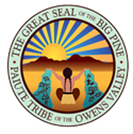Impacts of climate change on the Big Pine Tribe of the Owens Valley

Depleted groundwater, drought, air quality and decreased traditional foods are threatening the physical, cultural, and spiritual health of the Tribe, its habitats and ecosystems, and its built environment.
This document is written by L’eaux Stewart, a member of the Big Pine Tribe, and is based on her observations of climate change in the Owens Valley.
The Big Pine Paiute People, referred to here as the Big Pine Nümü, are comprised of three different groups from the Big Pine region. The boundaries of the traditional lands of the Big Pine Nümü begin at Keogh’s Hot Springs and extend south to Fish Springs. Two mountain ranges, the Whites and the Sierras, form the east and west boundaries. What used to be traditional lands are now residential and commercial properties, and land used for grazing and for pumping. Most of the land is owned by the Los Angeles Department of Water and Power (LADWP).
While the Big Pine Nümü did not use processes such as row crops, they practiced seed collection and plant grooming, to create improved materials. The creeks and streams were expanded to irrigate plants and to strand fish, making them easier to catch (see diagram below). Basket makers tended willows to improve basket making supplies. Saplings were groomed for bows and arrows. Oak and pine trees were cared for to ensure bountiful harvests.
Below: Hand drawn map of a Paiute irrigation system, drawn by Big Pine Paiute member Jack Stewart in Lawton, 1976

Over the past twenty years drought has become common. Rain and snowfall have significantly decreased. High winds have always been a part of the weather in the Owens Valley, but the frequency at which these winds occur is increasing, leading to soil erosion. Paired with the drought conditions, areas that once had established plant growth with deep root systems are now barren.
Petroglyphs and pictoglyphs have been damaged by erosion due to the increased dust storms. The pigments in the pictoglyphs are fading due to the wind erosion.
Wetland areas have nearly disappeared due to the water table dropping because of LADWP pumping and the lack of sustained rainy seasons. The Big Pine Nümü lands included many freshwater springs that have disappeared. Native fish species are on the endangered species list due to introduction of other fish species, destruction of habitat, and lack of water, the impacts of which are exacerbated by climate change.
Traditional foods such as Taboose (Cyperus esculentus), acorns, coyote potato, pine nuts, are no longer abundant due to climate change, accelerated by pumping by LADWP. Tule and cattail are no longer abundant due to the development of the lands that they grew on. Wetlands have dried up and houses or other development have replaced the tule beds.
There has been a decrease in Jackrabbits and Cottontails in the valley due to a combination of predators moving down into hunting areas and a lack of vegetation for the rabbits to eat. Larger predatory animals such as mountain lions and bears, as well as smaller predatory animals such as coyotes and bobcats have begun to appear more frequently on the reservation lands.
Bighorn Sheep, once a staple of the Owens Valley Paiute life, can no longer be hunted even for cultural purposes. The Big Pine Nümü have been supporting conservation efforts to restore the herds.
Below: A "Dust Devil" as seen from Route 168, heading east (Source: L’eaux Stewart)
During the 2020 fire season, residents of the Owens Valley were forced to remain indoors. During this time there was little wind, which allowed the smoke to settle over Big Pine. Not all residents own air conditioners, and their homes were too hot to safely live in.
With less rainfall, the more dust is carried by wind from areas north of town, affecting the breathing of community members, especially elders with lung issues and children with asthma. These dust clouds from alkaline soils irritate the respiratory system.
The difficulty of obtaining traditional foods through hunting and foraging has led to a change in diet for the people and has spanned multiple generations. Climate change caused a loss of wetlands, freshwater springs, plants, and animals. It has changed diets and cultural practices tied to water. We are experiencing extreme heat, more wind, and increased fire hazards. Without a return of water to the area, the Tribe is looking at scenarios where the land will not recover and the Big Pine Nümü may lose out on many of the practices that make up our culture.
This summary report and a more detailed report are available for download below.
